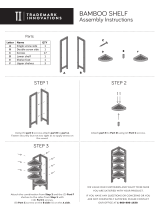3
Consumer SupportTroubleshooting TipsOperating InstructionsSafety Instructions Installation Instructions
IMPORTANT SAFETY INFORMATION.
READ ALL INSTRUCTIONS BEFORE USING.
www.GEAppliances.com
WARNING!
Use this appliance only for its intended purpose as described in this Owner’s Manual.
SAFETY PRECAUTIONS
When using electrical appliances, basic safety precautions should be followed, including the following:
■
■ This refrigerator must be properly installed
and located in accordance with the Installation
Instructions before it is used.
■
■ Do not allow children to climb, stand or hang
on the shelves in the refrigerator. They could
damage the refrigerator and seriously injure
themselves.
■
■ Do not touch the cold surfaces in the freezer
compartment when hands are damp or wet.
Skin may stick to these extremely cold surfaces.
■
■ Do not store or use gasoline or other flammable
vapors and liquids in the vicinity of this or any
other appliance.
■
■ Keep fingers out of the “pinch point” areas;
clearances between the doors and between
the doors and cabinet are necessarily small.
Be careful closing doors when children are
in the area.
■
■ In refrigerators with automatic icemakers,
avoid contact with the moving parts of the
ejector mechanism, or with the heating element
that releases the cubes. Do not place fingers or
hands on the automatic icemaking mechanism
while the refrigerator is plugged in.
■
■ Unplug the refrigerator before cleaning and
making repairs.
NOTE: We strongly recommend that any servicing be
performed by a qualified individual.
■
■ Turning the control to the 0 position does
not remove power to the light circuit.
■
■ Do not refreeze frozen foods which have
thawed completely.
MESURES DE SÉCURITÉ IMPORTANTES.
LISEZ D’ABORD TOUTES LES DIRECTIVES.
AVERTISSEMENT!
N’utilisez cet électroménager que pour l’usage auquel il est destiné, comme expliqué dans le
présent manuel.
MESURES DE SÉCURITÉ
Lorsque vous utilisez un appareil électrique, observez toujours les mesures de sécurité de base,
y compris les suivantes.
■ Installez le réfrigérateur conformément aux
directives d’installation avant de l’utiliser.
■ Ne laissez pas les enfants grimper, s’asseoir,
se tenir debout ni se pendre aux clayettes du
réfrigérateur. Ils pourraient endommager le
réfrigérateur et se blesser gravement.
■ N’entreposez et n’utilisez pas d’essence ou
autres vapeurs et liquides inflammables à
proximité de cet appareil ou de tout autre
appareil électroménager.
■ Éloignez les doigts des parties du réfrigérateur
où l’on peut facilement se pincer : les espaces
entre les portes et entre les portes et les placards
sont toujours étroits. Soyez prudent lorsque
vous fermez les portes de l’appareil en présence
des enfants.
■ Si votre réfrigérateur est doté d’une machine à
glaçons automatique évitez le contact avec les
pièces mobiles du mécanisme éjecteur, ou avec
l’élément chauffant qui libère les glaçons.
Ne posez pas les doigts ou les mains sur le
mécanisme de la machine à glaçons pendant
que le réfrigérateur est branché.
■ Ne touchez pas les surfaces froides du congélateur
si vous avez les mains humides ou mouillées : la
peau risque d’adhérer à ces surfaces très froides.
■ Débranchez votre réfrigérateur avant de le
nettoyer ou de le réparer.
REMARQUE : Nous vous recommandons vivement de
confier toute réparation à un technicien qualifié.
■ Lorsque vous réglez la commande sur 0 (éteint),
l’alimentation électrique de l’ampoule n’est pas
coupée.
■ Ne recongelez pas les aliments surgelés qui ont
complètement dégelé.





















